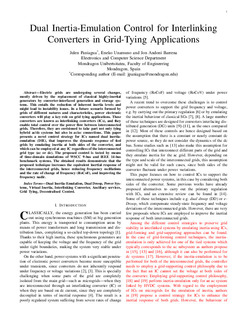Title
Dual Inertia-Emulation Control for Interlinking Converters in Grid-Tying ApplicationsVersion
Postprint
Rights
© 2021 IEEE. Personal use of this material is permitted. Permission from IEEE must be obtained for all other uses, in any current or future media, including reprinting/republishing this material for advertising or promotional purposes, creating new collective works, for resale or redistribution to servers or lists, or reuse of any copyrighted component of this work in other works.Access
Open accessPublisher’s version
https://doi.org/10.1109/TSG.2021.3078839Published at
IEEE Transactions on Smart Grid. Early AccessPublisher
IEEEKeywords
Dual Inertia-Emulation
Dual Droop
Power Systems
Virtual Inertia ... [+]
Dual Droop
Power Systems
Virtual Inertia ... [+]
Dual Inertia-Emulation
Dual Droop
Power Systems
Virtual Inertia
Interlinking Converter
Ancillary services
Grid Tying
Decentralised Control [-]
Dual Droop
Power Systems
Virtual Inertia
Interlinking Converter
Ancillary services
Grid Tying
Decentralised Control [-]
Abstract
Electric grids are undergoing several changes, mostly driven by the replacement of classical highly-inertial generators by converter-interfaced generation and storage systems. This entails the reducti ... [+]
Electric grids are undergoing several changes, mostly driven by the replacement of classical highly-inertial generators by converter-interfaced generation and storage systems. This entails the reduction of inherent inertia levels and might lead to instability issues. In a future scenario formed by grids of different natures and characteristics, power electronic converters will play a key role on grid tying applications. These converters are known as interlinking converters (ICs), and they enable total control over the power flow between interconnected grids. Therefore, they are envisioned to take part not only tying hybrid ac/dc systems but also in ac/ac connections. This paper presents a novel control strategy for ICs named dual inertiaemulation (DIE), that improves the dynamic response of tied grids by emulating inertia at both sides of the converter, and which can be employed at any IC regardless of the interconnected grid type (ac or dc). The proposed control is tested by means of time-domain simulations of WSCC 9-bus and IEEE 14-bus benchmark systems. The obtained results demonstrate that the proposed technique increases the equivalent inertial response of the interconnected grids, hence reducing frequency oscillations and the rate of change of frequency (RoCoF), and improving the frequency nadir. [-]
Collections
- Articles - Engineering [745]





















